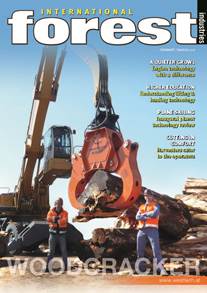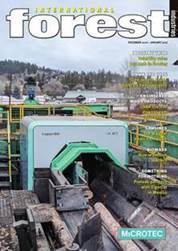EDITOR’S COMMENT ISSUE 55 FEB 2017 / MAR 2017
Coming up Trumps?
Predictably, given this is the first time I’ve had a chance to write a column since the United States elected Donald Trump to its most senior office, the next 550 words will be devoted to speculation about what his rise to power is likely to mean for forestry professionals.
The main focus has rightly been on Trump’s plan to spend some $1 trillion on infrastructure. While there is likely to be precious little wood used for his famous wall proposed to separate the US from its southern neighbour, Mexico, most building projects will be using a combination of wood products in vast amounts, particularly newly-developed, high-strength, engineered structural wood products.
The US forestry sector, particularly in its north, is theoretically in a position of strength, as it will all of a sudden have the responsibility of supplying new development ahead of imported suppliers.
Likewise, US-based equipment manufacturers, led by heavyweight John Deere, will be responsible for arming US contractors for what is expected to be an expanded market; while sawmills will also be mainly locally supplied.
This is obviously great news for these groups. On the flip side, there are obvious dangers to this approach.
Most immediately, one must feel for the Canadian forestry sector, which faces an uncertain period surrounding its key export market while the reality of Trump’s policies take shape.
And anyone who hoped perhaps he may be all mouth and no trousers when promising to put America first, need only look at his persistence in pursing his immigration promises in the face of international and legal opposition for evidence he is a man of conviction.
From a wider industry perspective, we may also be looking down the barrel of a period during which it becomes more difficult to innovate and collaborate across borders. The international industry has seen a number of company combinations that have seen European and North American innovation join forces for industry-reshaping results.
Trade partnerships have also allowed Europe’s overproducing biomass sector feed a US energy market that has been, until now, in overdrive to become greener. These partnerships have been thrown up in the air by the election result.
Beyond these threats is the wider economic issue of Trump starting an international trade war. Such an event would bring world trade to a near stand still, slowing GDP to a crawl and therefore hampering the need for development materials, such as wood.
A trade war is predicted by an alarming number of stakeholders as a relatively likely outcome from Trump’s near-term economic stimulus policies.
In Davos recently at the World Economic Forum, Chinese President Xi Jinping warned of the need to embrace globalisation and free trade at the same time Trump was readying himself for his inauguration and a period of enforcement for his protectionist, ‘America First’, policy.
You know you are living in a truly odd world when the head of the Chinese Communist Party is campaigning for free trade and the leader of the ‘Free World’ is talking about slapping taxes on any company looking to import its goods into the US.
In such a world, it is difficult predict anything, but in the International Forest Industries offices here in the UK, we are betting on a short-term period of growth for foresters followed by a prolonged period of uncertainty, at best.
Enjoy!
Chris Cann
Editor





